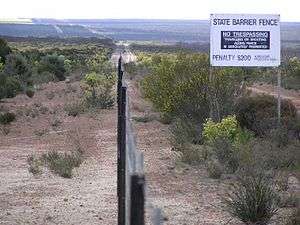Pest-exclusion fence
A pest-exclusion fence is a barrier that is built to exclude certain types of animal pests from an enclosure. This may be to protect plants in horticulture, preserve grassland for grazing animals, separate species carrying diseases (vector species) from livestock, prevent troublesome species entering roadways, or to protect endemic species in nature reserves. These fences are not necessarily traditional wire barriers, but may also include barriers of sound, or smell.[1]

Design techniques
Animals can be excluded by a fence's height, depth under the ground and mesh size. It is also important to choose a construction material that cannot be climbed; furthermore, sometimes it is necessary to create a subsurface fencing element to prevent burrowing under the fence.[2][3] Fences are usually designed with the target pest species (the species to be excluded) in mind, and the fences are made to effectively exclude those species. This results in a wide variety of designs for pest exclusion fences (see examples below).
Examples
- The 1.9m-high fence at the Orokonui Ecosanctuary in Waitati, New Zealand is designed to keep out all introduced mammals such as possums, rats, stoats, ferrets and even mice. It uses stainless steel mesh that continues down to form a skirt at ground level that prevents animals from burrowing under it. On the top is a curved steel hood that prevents climbers like cats and possums from climbing over the top.[4]
- Agricultural exclusion fences in central-western Queensland vary between 1.6m and 2m in height. The fences have a single top barbed wire and ring-lock or hinge-joint wire underneath and steel fence posts. The ring-lock or hinge joint wire has smaller holes at the bottom, gradually increasing in size to be marginally larger at the top. A section of this mesh lays flat against the ground at the bottom of the posts to form a skirt (or radial-apron) on the outside of the fence.[5]
- In Africa and Asia, crop-raiding elephants are excluded using a variety of techniques. These include electric fencing, fences of cacti, chilli-greased rope, and bee-hives or sounds of disturbed bees.[1]
Use in Australia
Barrier fencing
Australia has utilised exclusion fencing since the 1860s.[6] The most well known exclusion fences in Australia are the barrier fences. Barrier fences are long (usually linear) barriers erected for the purpose of excluding particular species from large portions of Australia. The most well known barrier fences are the Dingo Fence and the Rabbit-proof fence, but there are many others.
Agricultural exclusion fencing
In more recent years, pest-exclusion fences have been built around singular properties, or groups of properties.[7][5] This practice is known as cluster fencing.[7] Cluster fencing allows farmers to monitor and mitigate predation pressure on livestock, and monitor Total Grazing Pressure (TGP) through accurate abundance data of native, pest, and domestic herbivores.[5]
Use in New Zealand
Prior to human settlement New Zealand had no land-based mammals apart from three bat species. The introduced mammal species, such as rabbits, deer, and possum, have since caused huge ecological changes to the biota of New Zealand. Pest-exclusion fences are increasingly used for conservation of indigenous species by excluding all mammals.
Locations of predator-proof fences include:
- Cape Brett
- Cape Farewell
- Deans Bush, Christchurch
- Zealandia, Wellington
- Bushy Park
- Maungatautari Restoration Project
- Orokonui Ecosanctuary
- Shakespear Regional Park
- Styx Mill Reserve, Christchurch (under construction)
- Stewart Island
- Tawharanui Peninsula
See also
- Deer fence
- Rabbit-proof fence
- Dingo fence
- Ecological island
- Exclosure
References
- Hayward and Kerley (2009). "Fencing for conservation: Restriction of evolutionary potential or a riposte to threatening processes?". Biological Conservation. 142: 1–13. doi:10.1016/j.biocon.2008.09.022.
- Predator exclusion fence considerations Archived 14 October 2008 at the Wayback Machine
- "KWST fence design". Archived from the original on 24 July 2011. Retrieved 25 February 2011.
- First Major Milestone Achieved for the Orokonui Ecosanctuary on orokonui.org.nz Archived 4 July 2007 at the Wayback Machine
- RAPAD. "Not just a fence". Not just a fence.
- Long & Robley (July 2004). "Cost Effective Feral Animal Exclusion Fencing for Areas of High Conservation Value in Australia" (PDF). Cite journal requires
|journal=(help) - Paterson, M. "Cluster Fencing". RSPCA Queensland. Retrieved 12 February 2019.